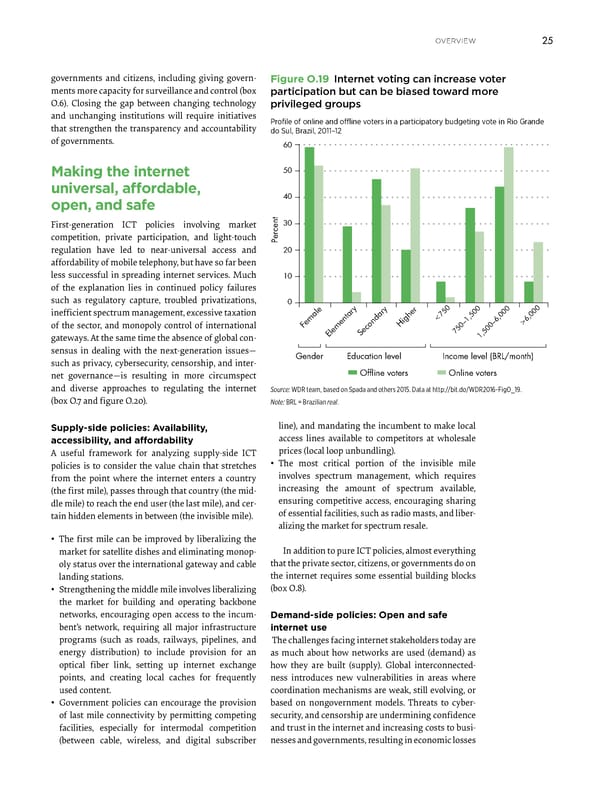overview 25 governments and citizens, including giving govern- Figure O.19 Internet voting can increase voter ments more capacity for surveillance and control (box participation but can be biased toward more O.6). Closing the gap between changing technology privileged groups and unchanging institutions will require initiatives Profile of online and offline voters in a participatory budgeting vote in Rio Grande that strengthen the transparency and accountability do Sul, Brazil, 2011–12 of governments. 60 Making the internet 50 universal, affordable, 40 open, and safe First-generation ICT policies involving market 30 competition, private participation, and light-touch Percent regulation have led to near-universal access and 20 affordability of mobile telephony, but have so far been less successful in spreading internet services. Much 10 of the explanation lies in continued policy failures such as regulatory capture, troubled privatizations, 0 inefficient spectrum management, excessive taxation <750 –1,500 –6,000 >6,000 of the sector, and monopoly control of international Female Higher gateways. At the same time the absence of global con- Elementary Secondary 750 1,500 sensus in dealing with the next-generation issues— Gender Education level Income level (BRL/month) such as privacy, cybersecurity, censorship, and inter- net governance—is resulting in more circumspect Offline voters Online voters and diverse approaches to regulating the internet Source: WDR team, based on Spada and others 2015. Data at http://bit.do/WDR2016-FigO_19. (box O.7 and figure O.20). Note: BRL = Brazilian real. Supply-side policies: Availability, line), and mandating the incumbent to make local accessibility, and affordability access lines available to competitors at wholesale A useful framework for analyzing supply-side ICT prices (local loop unbundling). policies is to consider the value chain that stretches • The most critical portion of the invisible mile from the point where the internet enters a country involves spectrum management, which requires (the first mile), passes through that country (the mid- increasing the amount of spectrum available, dle mile) to reach the end user (the last mile), and cer- ensuring competitive access, encouraging sharing tain hidden elements in between (the invisible mile). of essential facilities, such as radio masts, and liber- alizing the market for spectrum resale. • The first mile can be improved by liberalizing the market for satellite dishes and eliminating monop- In addition to pure ICT policies, almost everything oly status over the international gateway and cable that the private sector, citizens, or governments do on landing stations. the internet requires some essential building blocks • Strengthening the middle mile involves liberalizing (box O.8). the market for building and operating backbone networks, encouraging open access to the incum- Demand-side policies: Open and safe bent’s network, requiring all major infrastructure internet use programs (such as roads, railways, pipelines, and The challenges facing internet stakeholders today are energy distribution) to include provision for an as much about how networks are used (demand) as optical fiber link, setting up internet exchange how they are built (supply). Global interconnected- points, and creating local caches for frequently ness introduces new vulnerabilities in areas where used content. coordination mechanisms are weak, still evolving, or • Government policies can encourage the provision based on nongovernment models. Threats to cyber- of last mile connectivity by permitting competing security, and censorship are undermining confidence facilities, especially for intermodal competition and trust in the internet and increasing costs to busi- (between cable, wireless, and digital subscriber nesses and governments, resulting in economic losses
 World Development Report 2016 Page 39 Page 41
World Development Report 2016 Page 39 Page 41